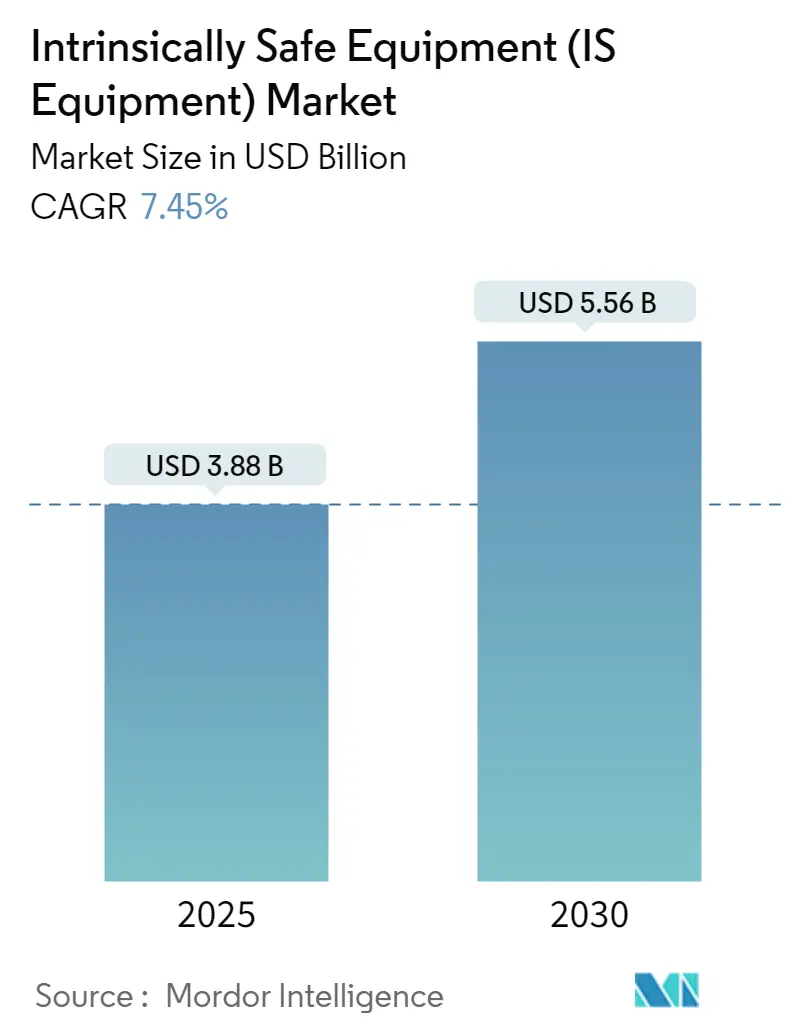
| Study Period | 2019 - 2030 |
| Market Size (2025) | USD 3.88 Billion |
| Market Size (2030) | USD 5.56 Billion |
| CAGR (2025 - 2030) | 7.45 % |
| Fastest Growing Market | Asia Pacific |
| Largest Market | Asia Pacific |
| Market Concentration | Low |
Major Players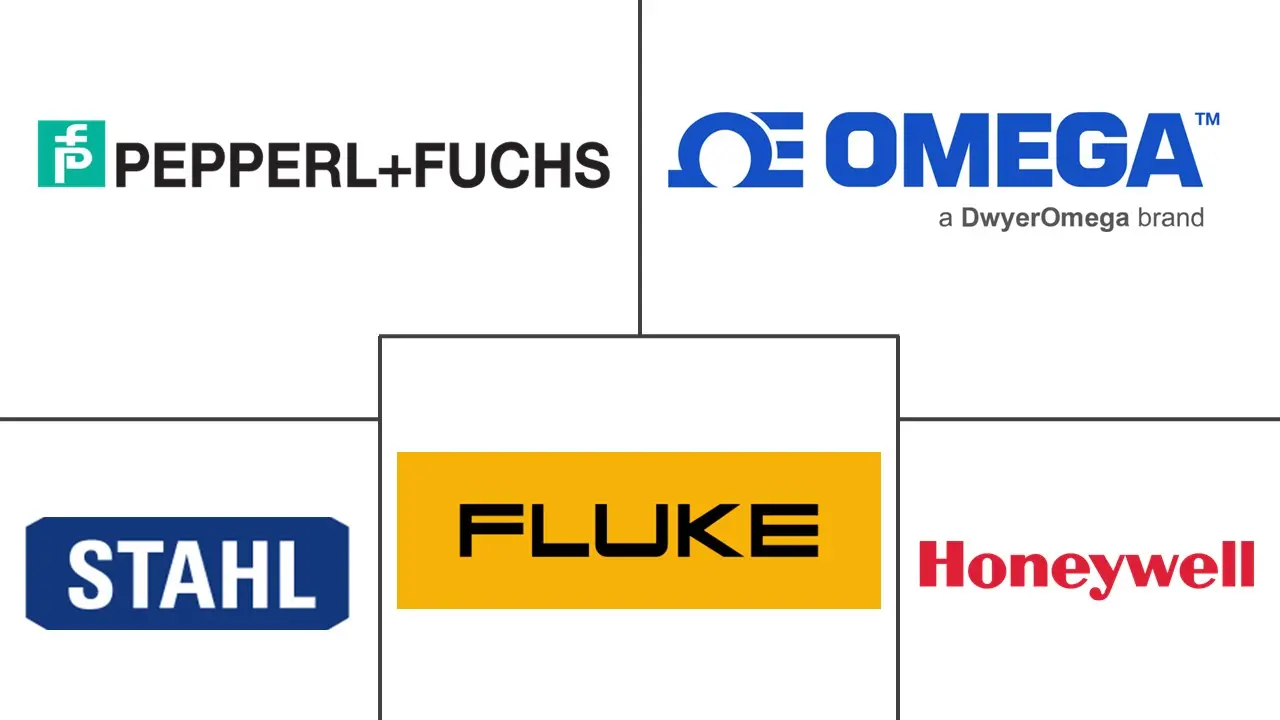
*Disclaimer: Major Players sorted in no particular order |
Intrinsically Safe Equipment (IS Equipment) Market Analysis
The Intrinsically Safe Equipment Market size is estimated at USD 3.88 billion in 2025, and is expected to reach USD 5.56 billion by 2030, at a CAGR of 7.45% during the forecast period (2025-2030).
The intrinsically safe equipment industry is experiencing significant transformation driven by broader industrial evolution and stringent safety requirements. According to the United Nations Industrial Organization, industrializing economies registered a year-over-year output increase of 4.9% in the third quarter of 2022, surpassing the growth rate of industrial economies. This industrial expansion has led to increased adoption of sophisticated industrial safety equipment across hazardous environments, particularly in process manufacturing sectors where the risk of explosions and accidents remains high. The integration of advanced technologies in industrial processes has necessitated more robust safety measures, driving innovations in intrinsically safe equipment design and functionality.
The oil and gas sector continues to be a primary growth catalyst for intrinsically safe equipment adoption. The International Energy Agency forecasts global upstream oil and gas investments to increase by about 11% to USD 528 billion in 2023, marking the highest level since 2015. This substantial investment surge reflects the industry's renewed focus on safety infrastructure and regulatory compliance, particularly in offshore and onshore exploration activities. The increasing complexity of oil and gas operations, combined with the presence of highly explosive atmospheres and flammable gases, has made explosion-proof equipment an indispensable component of operational safety protocols.
The market is witnessing a significant shift toward integrated safety solutions that combine multiple protection methods. Recent technological advancements have enabled the development of more sophisticated intrinsically safe equipment that can operate effectively in increasingly challenging environments. For instance, in September 2023, Red Sky Lighting's strategic partnership with Daly Middle East demonstrates the growing emphasis on region-specific safety solutions that comply with international standards such as IEC, ATEX equipment, and UL. This trend is particularly evident in the development of new sensors and monitoring systems that provide real-time hazard detection while maintaining intrinsic safety requirements.
The industry landscape is being reshaped by strategic investments and technological innovations aimed at enhancing safety standards. In March 2023, Pepperl+Fuchs introduced the KFU8-SR-EX universal powered switch amplifier, showcasing the industry's focus on developing more precise and reliable safety solutions. Similarly, in April 2023, Positek's launch of submersible and intrinsically safe apparatus for subsea applications highlights the market's evolution toward specialized solutions for extreme environments. These developments reflect the industry's commitment to addressing specific safety challenges while maintaining operational efficiency in hazardous areas.
Intrinsically Safe Equipment (IS Equipment) Market Trends
INCREASING NUMBER OF GOVERNMENT REGULATIONS
Government regulations worldwide are becoming increasingly stringent regarding workplace safety in hazardous environments. In the United States, the Occupational Safety and Health Administration (OSHA) regulations serve as the primary federal standards for occupational health and safety, while organizations like the American National Standards Institute (ANSI), Underwriters Laboratories (UL), and the National Fire Protection Association (NFPA) provide additional guidelines. The regulatory framework has evolved to encompass comprehensive safety requirements, particularly in industries where explosive atmospheres pose significant risks.
The implementation of these regulations varies significantly across regions, creating a complex compliance landscape for manufacturers and end-users. In Europe, the European Agency for Safety and Health at Work develops and promotes OHS policies and regulations, while countries like Taiwan enforce the Occupational Safety and Health Act. These diverse regulatory requirements have led to the development of international standards, such as those set by the International Electrotechnical Commission (IEC), which help harmonize safety requirements across different regions while maintaining stringent safety protocols.
GROWING ENERGY REQUIREMENTS, DRIVING THE DEMAND FOR EXPLORATION OF NEW MINES AND OIL AND GAS RESOURCES
The escalating global energy demand is driving extensive exploration activities in both the mining and oil & gas sectors. According to ScienceDirect, global energy demand projections indicate increasing consumption, expected to reach approximately 778 Etta Joules by 2035. This surge in energy requirements has led to increased exploration activities in challenging environments, including offshore drilling and unconventional resource extraction, necessitating advanced intrinsically safe equipment to ensure operational safety.
The expansion of energy exploration activities is evidenced by recent developments across the industry. In November 2023, China National Petroleum Corporation (CNPC) and Russian energy companies announced discussions over developing oil and gas fields, while in August 2023, Aramco from Saudi Arabia planned to ramp up oil output to 13 MMbl/d by 2027. Additionally, in October 2023, ADNOC awarded a contract worth USD 16.9 billion for building a major gas project in Hail and Ghasha offshore fields. These developments, coupled with the inherent risks in energy exploration, have intensified the need for sophisticated hazardous area equipment to protect personnel and assets in hazardous environments.
Segment Analysis: ZONE
Zone 1 Segment in Intrinsically Safe Equipment Market
Zone 1 has emerged as both the largest and fastest-growing segment in the intrinsically safe equipment market, commanding approximately 39% market share in 2024. This segment encompasses areas where explosive atmospheres are occasionally expected in regular operation, particularly in locations such as petrol stations and areas adjacent to Zone 0 locations. The segment's dominance is primarily driven by its extensive application in the oil and gas, chemicals, and petroleum industries, as well as processing sectors. The stringent installation requirements for Zone 1, which are more demanding than Zone 2 requirements, have led to increased adoption of sophisticated safe equipment and monitoring systems. The growth is further fueled by the rising focus on workplace safety, particularly in regions with high industrial activity and strict regulatory frameworks. Additionally, the segment's expansion is supported by technological advancements in intrinsically safe equipment, including the development of more efficient and reliable safety systems specifically designed for Zone 1 environments.
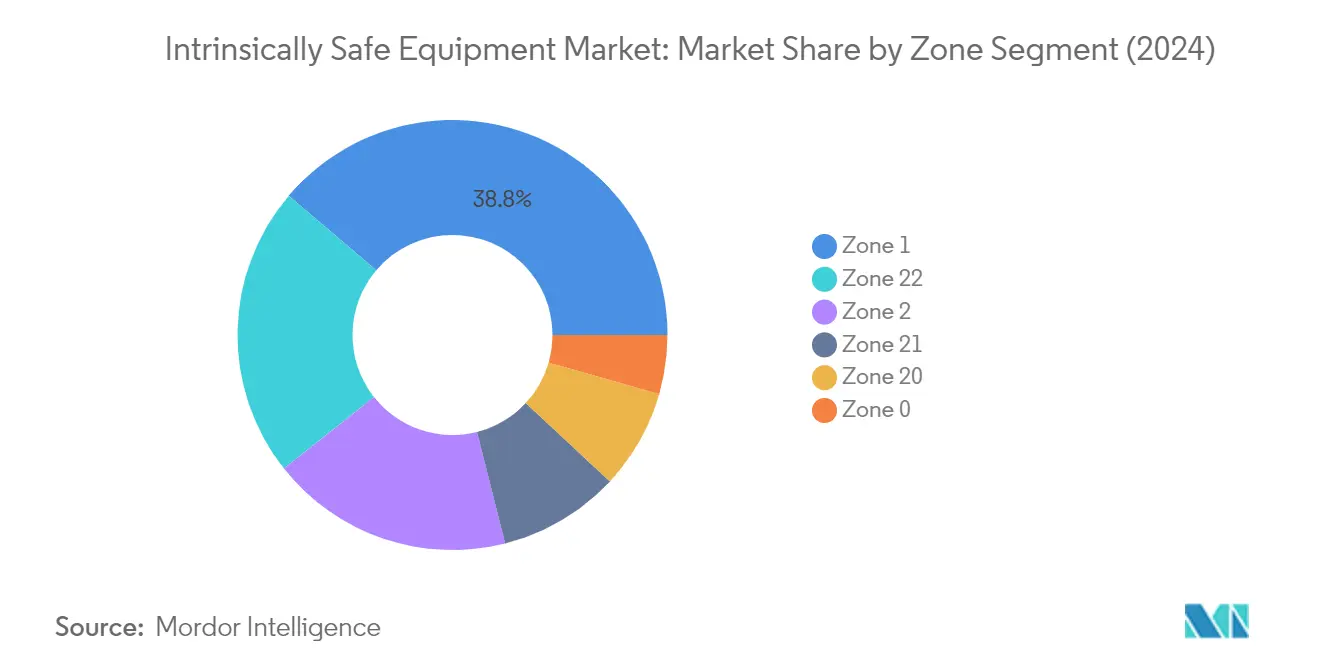
Remaining Segments in Zone Classification
The other zones in the intrinsically safe equipment market serve distinct safety requirements across various industrial applications. Zone 22, the second-largest segment, primarily caters to areas where combustible dust or ignitable fibers are present for short periods, typically in warehouses and storage areas. Zone 2 applications focus on areas where hazardous atmospheres are not likely during normal operation, while Zone 20 addresses locations with a continuous presence of explosive dust atmospheres. Zone 21 is crucial for processing areas where dust and powders are more likely to be present, and Zone 0, though smaller in market share, serves critical applications in areas with a continuous presence of explosive atmospheres. Each of these zones requires specific certification levels and safety measures, contributing to the overall market dynamics and safety standards across industries.
Segment Analysis: CLASS
Class 1 Segment in Intrinsically Safe Equipment Market
The Class 1 segment dominates the intrinsically safe equipment market, commanding approximately 58% market share in 2024, driven by its critical role in areas where flammable gases, vapors, or liquids are present. This segment's prominence is attributed to the increasing adoption of intrinsically safe apparatus in high-risk environments such as oil and gas, petrochemicals, and chemical manufacturing industries. Class 1 locations are further classified into Division 1 and Division 2, with specific requirements for equipment design and certification. The segment's growth is supported by stringent regulatory compliance requirements, particularly in North America and Europe, where Class 1 certification is mandatory for equipment operating in hazardous areas. The rising focus on workplace safety, coupled with the expansion of industries dealing with flammable substances, continues to drive the demand for Class 1 certified explosion-proof equipment.
Class 2 Segment in Intrinsically Safe Equipment Market
The Class 2 segment of the intrinsically safe equipment market is experiencing significant growth, with a focus on environments where combustible dust poses explosion risks. This segment's expansion is driven by increasing safety concerns in industries such as grain handling, food processing, pharmaceutical manufacturing, and chemical processing. The implementation of stricter safety regulations worldwide and the growing awareness of dust explosion hazards are key factors propelling the adoption of Class 2 certified flameproof equipment. The segment is witnessing technological advancements in dust detection and prevention systems, with manufacturers developing more sophisticated and reliable solutions. The integration of IoT and interconnected systems in Class 2 environments is enabling real-time monitoring and preventive actions, further enhancing the segment's growth prospects.
Remaining Segments in Class Segmentation
The Class 3 segment in the intrinsically safe equipment market addresses the specific needs of environments where easily ignitable fibers or flyings are present. This segment primarily serves industries such as textile manufacturing, woodworking, and materials processing facilities. The segment's importance is underscored by its role in preventing fire hazards associated with combustible fibers and maintaining workplace safety standards. Class 3 equipment manufacturers focus on developing robust housings and protective measures to withstand the unique challenges presented by these environments. The segment continues to evolve with the introduction of new safety technologies and solutions specifically designed for fiber-rich industrial environments.
Segment Analysis: BY PRODUCTS
Sensors Segment in Intrinsically Safe Equipment Market
The sensors segment continues to dominate the intrinsically safe equipment market, holding approximately 22% market share in 2024. This significant market position is attributed to the increasing adoption of intrinsically safe apparatus across various hazardous environments, particularly in the oil and gas, chemical processing, mining, and pharmaceuticals industries. These sensors are specifically engineered to limit power and heat generation to levels below what is required to ignite hazardous atmospheres, making them crucial for ensuring safety in explosive environments. The segment's growth is further bolstered by technological advancements in sensing capabilities, including developments in fiber optic sensing technology and wireless intrinsically safe equipment sensors. Modern intrinsically safe equipment sensors undergo rigorous testing and certification processes to ensure compliance with safety standards from organizations such as FM, CSA, ATEX, and IECEx, enhancing their reliability and market acceptance.
Transmitters Segment in Intrinsically Safe Equipment Market
The transmitters segment is emerging as the fastest-growing category in the intrinsically safe equipment market, with an expected growth rate of approximately 9% during 2024-2029. This remarkable growth is driven by the increasing demand for reliable data transmission in hazardous environments, particularly in process industries where accurate measurement and signal conversion are crucial. The segment's expansion is supported by technological innovations such as advanced graphical LCD displays, HART digital communication capabilities, and enhanced connectivity features. Intrinsically safe equipment transmitters are increasingly being integrated with smart technologies and IoT capabilities, enabling seamless communication and real-time monitoring in hazardous areas. The segment's growth is further accelerated by the rising adoption of wireless transmission technologies and the development of more sophisticated pressure, temperature, humidity, and other types of measurements in explosive atmospheres.
Remaining Segments in Products Market Segmentation
The intrinsically safe equipment market encompasses several other crucial segments including detectors, switches, isolators, LED indicators, and other specialized products. Detectors play a vital role in hazard detection and monitoring, featuring advanced functionality such as dual audible alarm ports and multi-sensor capabilities. Switches are essential for controlling electrical circuits in hazardous environments, while isolators maintain system integrity by preventing excess energy transfer. LED indicators provide crucial visual feedback in hazardous areas, incorporating features like super-bright LEDs for high visibility. Each of these segments contributes uniquely to the overall market ecosystem, addressing specific safety requirements across different industrial applications and hazardous environments. The continuous innovation in these segments, particularly in terms of enhanced safety features, improved reliability, and integration capabilities, further strengthens their position in the market.
Segment Analysis: BY END USER INDUSTRY
Oil and Gas Segment in Intrinsically Safe Equipment Market
The oil and gas industry continues to dominate the intrinsically safe equipment market, holding approximately 30% market share in 2024. This significant market position is driven by the industry's inherent need for hazardous area equipment in environments where flammable gases and explosive atmospheres are common. The sector's extensive use of intrinsically safe equipment spans across oil refineries, drilling rigs, and petrochemical plants, where these devices play a crucial role in preventing explosions and ensuring worker safety. The implementation of stringent safety regulations worldwide and the growing emphasis on workplace safety in oil and gas facilities has further strengthened the demand for intrinsically safe equipment in this sector. The increasing exploration activities in offshore and onshore oil fields, coupled with the expansion of existing facilities, continue to drive the demand for various intrinsically safe equipment products including sensors, detectors, switches, and other safety monitoring equipment.
Chemical and Petrochemical Segment in Intrinsically Safe Equipment Market
The chemical and petrochemical segment is emerging as the fastest-growing sector in the intrinsically safe equipment market, with a projected growth rate of approximately 9% during 2024-2029. This robust growth is primarily attributed to the increasing automation and digitalization initiatives in chemical processing facilities, which require advanced safety systems and monitoring equipment. The segment's growth is further fueled by stringent safety regulations and the rising awareness about workplace safety in chemical manufacturing facilities. The expansion of petrochemical production capacities, particularly in emerging economies, coupled with the modernization of existing facilities, is creating substantial opportunities for intrinsically safe equipment manufacturers. The industry's focus on preventing accidents in hazardous areas and the growing implementation of smart manufacturing concepts are driving the adoption of sophisticated intrinsically safe equipment sensors, detectors, and monitoring systems.
Remaining Segments in End User Industry
The mining, power, and processing industries represent significant segments in the intrinsically safe equipment market, each with unique safety requirements and application needs. The mining sector particularly emphasizes the use of intrinsically safe equipment due to the presence of combustible dust and gases in underground operations. The power generation industry requires these safety devices across various applications, especially in areas handling combustible materials and hazardous substances. The processing industry, including food and beverage manufacturing, relies on intrinsically safe equipment to maintain safety standards in areas where flammable materials are present. These segments collectively contribute to the market's diversity and demonstrate the widespread application of intrinsically safe equipment across various industrial sectors, each driven by specific safety requirements and regulatory compliance needs.
Intrinsically Safe Equipment Market Geography Segment Analysis
Intrinsically Safe Equipment Market in North America
North America represents a mature intrinsically safe equipment market, driven by stringent safety regulations and the presence of established oil & gas, mining, and chemical industries. The United States and Canada are the key markets in this region, with both countries maintaining robust regulatory frameworks through organizations like OSHA, UL, and CSA. The region's focus on workplace safety, coupled with increasing investments in industrial automation and hazardous area protection, continues to drive market growth.
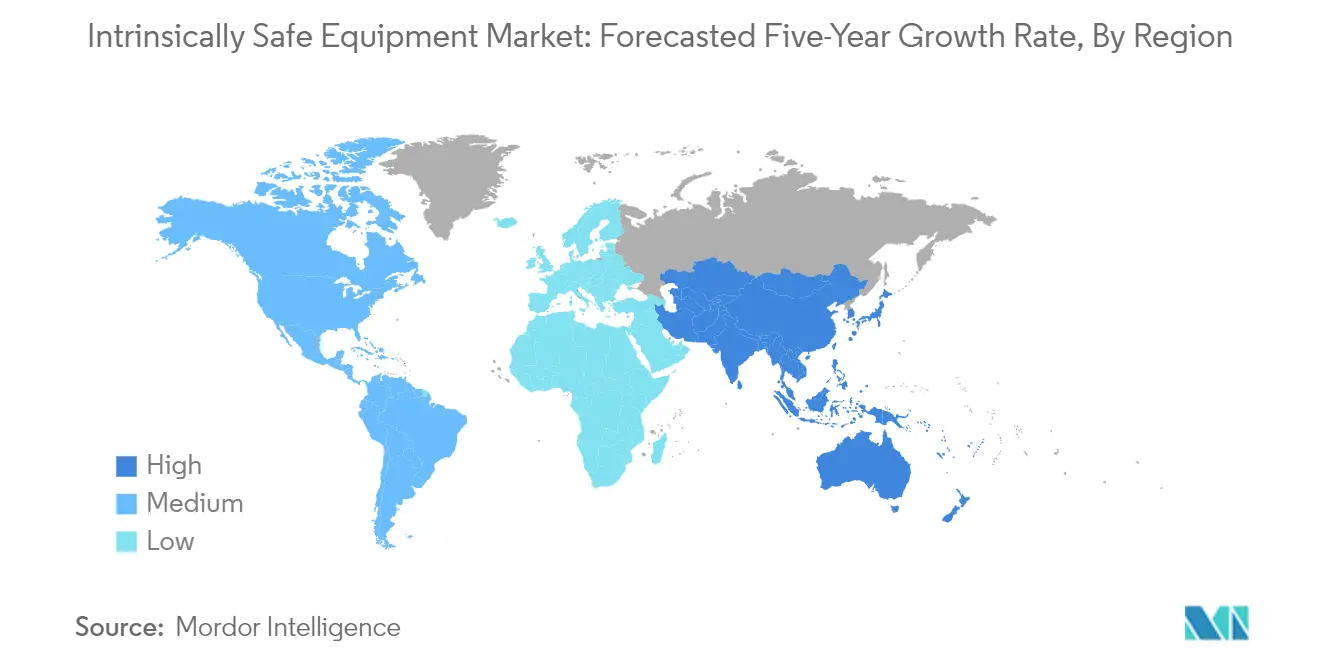
Intrinsically Safe Equipment Market in the United States
The United States dominates the North American intrinsically safe equipment market, accounting for approximately 84% of the regional market share in 2024. The country's leadership position is reinforced by its extensive oil and gas operations, chemical processing facilities, and mining activities. The presence of major regulatory bodies such as OSHA, Factory Mutual (FM3610), and the National Fire Protection Association (NFPA) has established comprehensive safety standards that drive the adoption of intrinsically safe equipment. The market is further strengthened by continuous technological advancements and the increasing focus on industrial safety across hazardous environments.
Intrinsically Safe Equipment Market in Canada
Canada represents a growing market for intrinsically safe equipment, with a projected growth rate of around 5% during 2024-2029. The country's expanding mining sector and significant oil and gas operations, particularly in regions like Alberta and Saskatchewan, drive the demand for intrinsically safe equipment. The Canadian market is characterized by strict adherence to safety regulations through the Canadian Electrical Code (CEC) and CSA standards. The country's focus on resource extraction and processing industries, combined with increasing investments in workplace safety, continues to create opportunities for market expansion.
Intrinsically Safe Equipment Market in Europe
Europe maintains a strong position in the global intrinsically safe equipment market, supported by comprehensive ATEX directives and stringent safety regulations. The region's market is characterized by the presence of major manufacturing hubs in Germany, the United Kingdom, and France. The European market benefits from advanced industrial infrastructure and the continuous evolution of safety standards, particularly in chemical processing, oil and gas, and manufacturing sectors.
Intrinsically Safe Equipment Market in Germany
Germany leads the European intrinsically safe equipment market, commanding approximately 32% of the regional market share in 2024. The country's dominance is attributed to its robust manufacturing sector, particularly in chemical processing and industrial automation. Germany's leadership in Industry 4.0 initiatives and the presence of major intrinsically safe equipment manufacturers contribute to its market prominence. The country's comprehensive regulatory framework and focus on technological innovation continue to drive market growth.
Intrinsically Safe Equipment Market in the United Kingdom
The United Kingdom demonstrates strong growth potential in the intrinsically safe equipment market, with a projected growth rate of around 7% during 2024-2029. The country's market is driven by significant investments in oil and gas operations, particularly in the North Sea region. The UK's emphasis on industrial safety standards and the presence of established certification bodies contribute to market expansion. The growing focus on renewable energy projects and the modernization of industrial facilities further support market growth.
Intrinsically Safe Equipment Market in Asia-Pacific
The Asia-Pacific region represents a dynamic intrinsically safe equipment market, driven by rapid industrialization and increasing safety awareness across various sectors. China, Japan, and India emerge as key markets, each contributing significantly to regional growth. The region's expansion is supported by growing investments in manufacturing, mining, and oil and gas sectors, coupled with evolving safety regulations.
Intrinsically Safe Equipment Market in China
China maintains its position as the largest market in the Asia-Pacific region, driven by extensive industrial operations and stringent safety requirements. The country's robust manufacturing sector, coupled with significant investments in chemical processing and mining operations, fuels market growth. China's commitment to industrial safety standards and the presence of domestic manufacturers contribute to market expansion.
Intrinsically Safe Equipment Market in India
India emerges as the fastest-growing market in the Asia-Pacific region, supported by rapid industrial expansion and increasing focus on workplace safety. The country's growth is driven by substantial investments in oil and gas exploration, chemical processing, and manufacturing sectors. India's evolving regulatory framework and growing emphasis on industrial safety standards continue to create new opportunities for market development.
Intrinsically Safe Equipment Market in Latin America
The Latin American market for intrinsically safe equipment demonstrates steady growth, driven by expanding industrial activities across Brazil, Mexico, and Argentina. Brazil emerges as the largest market in the region, benefiting from its extensive oil and gas operations and chemical processing facilities. Mexico shows the fastest growth potential, supported by increasing investments in manufacturing and energy sectors. The region's market development is characterized by growing awareness of industrial safety standards and increasing investments in hazardous area protection.
Intrinsically Safe Equipment Market in the Middle East & Africa
The Middle East & Africa region presents significant opportunities in the intrinsically safe equipment market, primarily driven by extensive oil and gas operations and growing industrial infrastructure. Saudi Arabia emerges as the largest market in the region, supported by its dominant position in the oil and gas sector. The United Arab Emirates demonstrates the fastest growth potential, driven by diversification efforts and increasing investments in industrial safety. The region's market is characterized by strict safety regulations and growing emphasis on workplace protection in hazardous environments.
Intrinsically Safe Equipment (IS Equipment) Market Overview
Top Companies in Intrinsically Safe Equipment Market
The intrinsically safe equipment market is characterized by the presence of established players like Pepperl + Fuchs, Fluke Corporation, OMEGA Engineering, R. Stahl AG, Honeywell International, and Eaton Corporation, leading the innovation landscape. Companies are focusing on developing advanced safety solutions incorporating IoT capabilities and AI-driven predictive maintenance features to enhance operational efficiency. Strategic partnerships and collaborations, particularly in emerging markets, have become crucial for expanding market presence and technological capabilities. Manufacturers are increasingly investing in research and development to create miniaturized, energy-efficient products while maintaining robust safety standards. The industry has witnessed a significant push towards developing integrated solutions that combine multiple intrinsically safe equipment features in single devices, along with enhanced wireless connectivity options for remote monitoring and control.
Consolidated Market with Strong Regional Leaders
The intrinsically safe equipment market exhibits a concentrated structure dominated by large multinational corporations with extensive manufacturing and distribution networks. These major players leverage their broad product portfolios, established brand reputation, and strong financial capabilities to maintain their market positions. The market has seen a mix of global conglomerates and specialized regional players, with the latter focusing on specific geographic regions or niche product segments. The industry landscape is marked by strategic acquisitions and partnerships, particularly in regions like Asia-Pacific and the Middle East, as companies seek to expand their geographical footprint and technological capabilities.
The competitive dynamics are shaped by companies' ability to offer comprehensive solutions while maintaining compliance with varying regional safety standards and certifications. Market consolidation has been driven by larger players acquiring smaller, specialized manufacturers to enhance their product offerings and access new market segments. Companies with strong distribution networks and after-sales service capabilities have gained significant advantages, particularly in serving industries like oil and gas, chemical processing, and mining, where intrinsically safe equipment reliability and safety are paramount.
Innovation and Compliance Drive Market Success
Success in the intrinsically safe equipment market increasingly depends on companies' ability to balance technological innovation with stringent safety compliance requirements. Market leaders are investing in developing smart, connected devices that offer enhanced monitoring capabilities while maintaining intrinsic safety standards. Companies focusing on developing customized solutions for specific industry applications, particularly in high-risk environments, are gaining competitive advantages. The ability to provide comprehensive training, technical support, and maintenance services has become crucial for maintaining customer relationships and ensuring long-term market success.
For new entrants and smaller players, success lies in identifying and serving niche market segments with specialized products and solutions. The market presents opportunities for companies that can effectively address specific industry challenges while maintaining competitive pricing structures. Regulatory compliance remains a critical factor, with successful companies demonstrating the ability to navigate complex certification requirements across different regions. The increasing focus on workplace safety and environmental regulations continues to shape product development and market strategies, while the growing adoption of Industry 4.0 technologies creates new opportunities for innovation in intrinsically safe apparatus.
Intrinsically Safe Equipment (IS Equipment) Market Leaders
-
Pepperl + Fuchs
-
Fluke Corporation (Fortive Corporation)
-
OMEGA Engineering
-
R. Stahl AG
-
Honeywell International Inc.
- *Disclaimer: Major Players sorted in no particular order
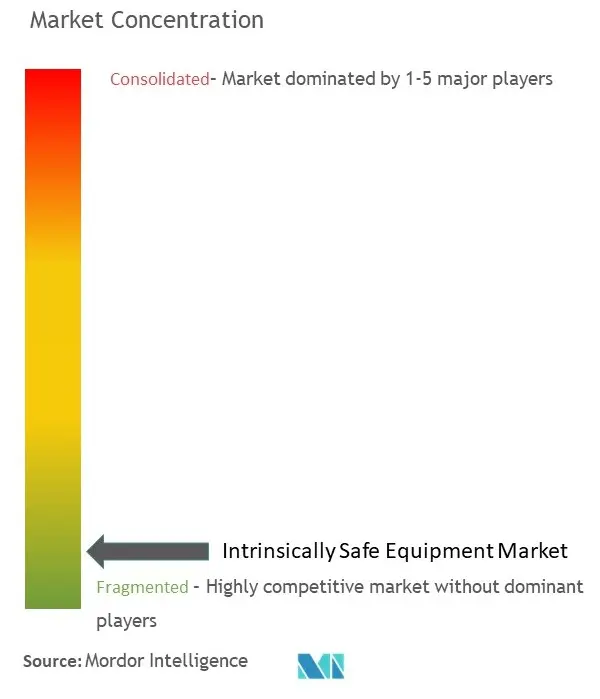
Intrinsically Safe Equipment (IS Equipment) Market News
- November 2023 - Amazon Inc. launched an AWS Monitron solution that uses machine learning (ML) to identify anomalies in industrial equipment for predictive maintenance. It includes wireless sensors for vibration and temperature monitoring; gateways for automatic data transfer to AWS Cloud, a service that analyses the data for anomalies using ML; and an accompanying mobile app to configure the devices and get operating behavior reports and machine failure alerts.
- September 2023 - Red Sky Lighting, a lighting manufacturer based in California, selected Daly Middle East as its esteemed strategic partner for the United Arab Emirates, Bahrain, and Oman. This esteemed partnership entails Daly Middle East distributing Red Sky Lighting's comprehensive range of lighting products across the Gulf Cooperation Council (GCC) countries: Bahrain, Kuwait, Oman, Qatar, Saudi Arabia, and the United Arab Emirates. The product range includes lighting solutions that adhere to IEC, ATEX, or U.L. standards, ensuring safety in explosive atmospheres caused by gases, flammable fibers, filings, and dust particles. Additionally, these products possess temperature ratings that make them suitable for hazardous and challenging industrial environments.
Intrinsically Safe Equipment (IS Equipment) Market Report - Table of Contents
1. INTRODUCTION
- 1.1 Study Assumptions and Market Definition
- 1.2 Scope of the Study
2. RESEARCH METHODOLOGY
3. EXECUTIVE SUMMARY
4. MARKET INSIGHTS
- 4.1 Market Overview
-
4.2 Industry Attractiveness - Porter's Five Forces Analysis
- 4.2.1 Threat of New Entrants
- 4.2.2 Bargaining Power of Buyers
- 4.2.3 Bargaining Power of Suppliers
- 4.2.4 Threat of Substitute Products
- 4.2.5 Intensity of Competitive Rivalry
- 4.3 Industry Value Chain Analysis
- 4.4 Impact of COVID-19 Aftereffects and Other Macroeconomic Factors on the Market
5. MARKET DYNAMICS
-
5.1 Market Drivers
- 5.1.1 Increasing Number of Government Regulations
- 5.1.2 Growing Energy Requirements, Driving the Demand for Exploration of New Mines and Oil and Gas Resources
-
5.2 Market Challenges
- 5.2.1 Varying Safety Regulations Across Different Regions
- 5.2.2 Cost and Design Complexity
6. MARKET SEGMENTATION
-
6.1 By Zone
- 6.1.1 Zone 0
- 6.1.2 Zone 20
- 6.1.3 Zone 1
- 6.1.4 Zone 21
- 6.1.5 Zone 2
- 6.1.6 Zone 22
-
6.2 By Class
- 6.2.1 Class 1
- 6.2.2 Class 2
- 6.2.3 Class 3
-
6.3 By Products
- 6.3.1 Sensors
- 6.3.2 Detectors
- 6.3.3 Switches
- 6.3.4 Transmitters
- 6.3.5 Isolators
- 6.3.6 LED Indicators
- 6.3.7 Others Products
-
6.4 By End User
- 6.4.1 Oil and Gas
- 6.4.2 Mining
- 6.4.3 Power
- 6.4.4 Chemical and Petrochemical
- 6.4.5 Processing
- 6.4.6 Other End Users
-
6.5 By Geography
- 6.5.1 North America
- 6.5.1.1 United States
- 6.5.1.2 Canada
- 6.5.2 Europe
- 6.5.2.1 Germany
- 6.5.2.2 United Kingdom
- 6.5.2.3 France
- 6.5.2.4 Rest of Europe
- 6.5.3 Asia-Pacific
- 6.5.3.1 China
- 6.5.3.2 Japan
- 6.5.3.3 India
- 6.5.3.4 Rest of Asia-Pacific
- 6.5.4 Latin America
- 6.5.4.1 Brazil
- 6.5.4.2 Mexico
- 6.5.4.3 Argentina
- 6.5.4.4 Rest of Latin America
- 6.5.5 Middle East & Africa
- 6.5.5.1 Saudi Arabia
- 6.5.5.2 United Arab Emirates
- 6.5.5.3 Rest of Middle East & Africa
7. COMPETITIVE LANDSCAPE
-
7.1 Company Profiles*
- 7.1.1 Pepperl + Fuchs
- 7.1.2 Fluke Corporation (Fortive Corporation)
- 7.1.3 OMEGA Engineering (Spectris PLC)
- 7.1.4 R. Stahl AG
- 7.1.5 Honeywell International Inc.
- 7.1.6 Eaton Corporation PLC
- 7.1.7 CorDEX Instruments Ltd
- 7.1.8 Bayco Products Inc.
- 7.1.9 Kyland Technology Co. Ltd
- 7.1.10 Banner Engineering Corp.
- 7.1.11 Georgin
8. INVESTMENT ANALYSIS
9. FUTURE OF THE MARKET
Intrinsically Safe Equipment (IS Equipment) Market Industry Segmentation
Intrinsically safe equipment is defined as "equipment and wiring which are incapable of releasing sufficient electrical or thermal energy under normal or abnormal conditions to cause ignition of a specific hazardous atmospheric mixture in its most easily ignited concentration." This is achieved by limiting the amount of power available to the electrical equipment in the hazardous area to a level below that which will ignite the gases.
The study tracks the revenue accrued through the sale of video telematics by various players in the global market. The study also tracks the key market parameters, underlying growth influencers, and major vendors operating in the industry that support the market estimations and growth rates over the forecast period. The study further analyses the overall impact of COVID-19 aftereffects and other macroeconomic factors on the market. The report’s scope encompasses market sizing and forecasts for the various market segments.
The intrinsically safe equipment market is segmented by zone (zone 0, zone 20, zone1, zone 21, zone 2, and zone 22), class (class 1, class 2, and class 3), products (sensors, detectors, switches, transmitters, isolators, LED indicators, and other products), end-user industry (oil and gas, mining, power, chemical and petrochemical, processing, and other end-user industries), and geography (North America [United States and Canada], Europe [Germany, United Kingdom, France, and Rest of Europe], Asia-Pacific [China, Japan, India, and Rest of Asia-Pacific], Latin America [Brazil, Mexico, Argentina, and Rest of Latin America], Middle East & Africa [Saudi Arabia, United Arab Emirates, and Rest of Middle East & Africa]). The market sizes and forecasts are provided in terms of value (USD) for all the above segments.
| By Zone | Zone 0 | ||
| Zone 20 | |||
| Zone 1 | |||
| Zone 21 | |||
| Zone 2 | |||
| Zone 22 | |||
| By Class | Class 1 | ||
| Class 2 | |||
| Class 3 | |||
| By Products | Sensors | ||
| Detectors | |||
| Switches | |||
| Transmitters | |||
| Isolators | |||
| LED Indicators | |||
| Others Products | |||
| By End User | Oil and Gas | ||
| Mining | |||
| Power | |||
| Chemical and Petrochemical | |||
| Processing | |||
| Other End Users | |||
| By Geography | North America | United States | |
| Canada | |||
| Europe | Germany | ||
| United Kingdom | |||
| France | |||
| Rest of Europe | |||
| Asia-Pacific | China | ||
| Japan | |||
| India | |||
| Rest of Asia-Pacific | |||
| Latin America | Brazil | ||
| Mexico | |||
| Argentina | |||
| Rest of Latin America | |||
| Middle East & Africa | Saudi Arabia | ||
| United Arab Emirates | |||
| Rest of Middle East & Africa | |||
Intrinsically Safe Equipment (IS Equipment) Market Research FAQs
How big is the Intrinsically Safe Equipment Market?
The Intrinsically Safe Equipment Market size is expected to reach USD 3.88 billion in 2025 and grow at a CAGR of 7.45% to reach USD 5.56 billion by 2030.
What is the current Intrinsically Safe Equipment Market size?
In 2025, the Intrinsically Safe Equipment Market size is expected to reach USD 3.88 billion.
Who are the key players in Intrinsically Safe Equipment Market?
Pepperl + Fuchs, Fluke Corporation (Fortive Corporation), OMEGA Engineering, R. Stahl AG and Honeywell International Inc. are the major companies operating in the Intrinsically Safe Equipment Market.
Which is the fastest growing region in Intrinsically Safe Equipment Market?
Asia Pacific is estimated to grow at the highest CAGR over the forecast period (2025-2030).
Which region has the biggest share in Intrinsically Safe Equipment Market?
In 2025, the Asia Pacific accounts for the largest market share in Intrinsically Safe Equipment Market.
What years does this Intrinsically Safe Equipment Market cover, and what was the market size in 2024?
In 2024, the Intrinsically Safe Equipment Market size was estimated at USD 3.59 billion. The report covers the Intrinsically Safe Equipment Market historical market size for years: 2019, 2020, 2021, 2022, 2023 and 2024. The report also forecasts the Intrinsically Safe Equipment Market size for years: 2025, 2026, 2027, 2028, 2029 and 2030.
Our Best Selling Reports
Intrinsically Safe Equipment (IS Equipment) Market Research
Mordor Intelligence provides comprehensive insights into the intrinsically safe equipment market through detailed industry analysis, market size assessment, and growth forecasts. Our research extensively covers various segments including explosion proof equipment, hazardous area equipment, and intrinsically safe devices, offering stakeholders a thorough understanding of market dynamics and emerging opportunities. The report pdf includes in-depth analysis of market leaders, technology trends, and regulatory frameworks governing safe equipment deployment across hazardous environments, helping businesses make informed decisions about their investments in intrinsically safe apparatus and related solutions.
Our consulting expertise extends beyond traditional market research to provide strategic insights for stakeholders in the industrial safety equipment sector. We assist clients with regulatory assessment and compliance strategies for hazardous location equipment, technology scouting for emerging safety solutions, and competition assessment to identify market gaps and opportunities. Our team conducts comprehensive B2B surveys and interviews with industry experts, safety consultants, and end-users to understand implementation challenges and success factors. We also support businesses with product positioning assessments, new product launch strategies, and customer need analysis, ensuring that their intrinsically safe instruments and explosion protected equipment meet market demands and safety standards effectively.




